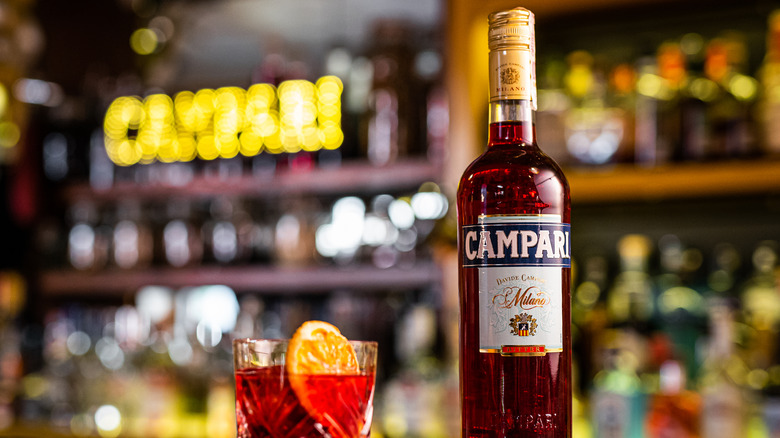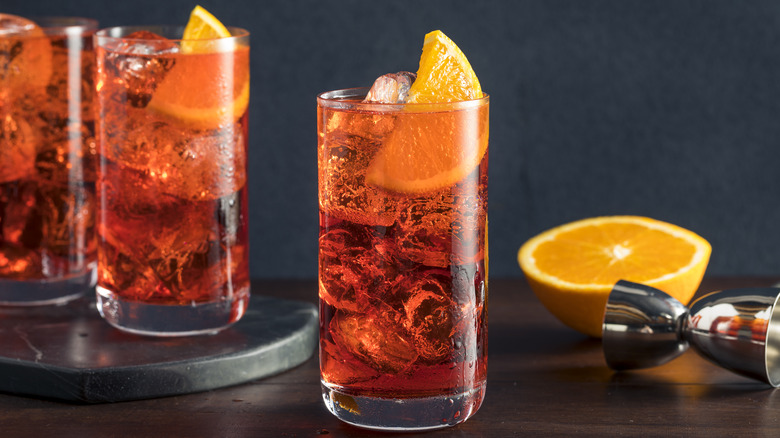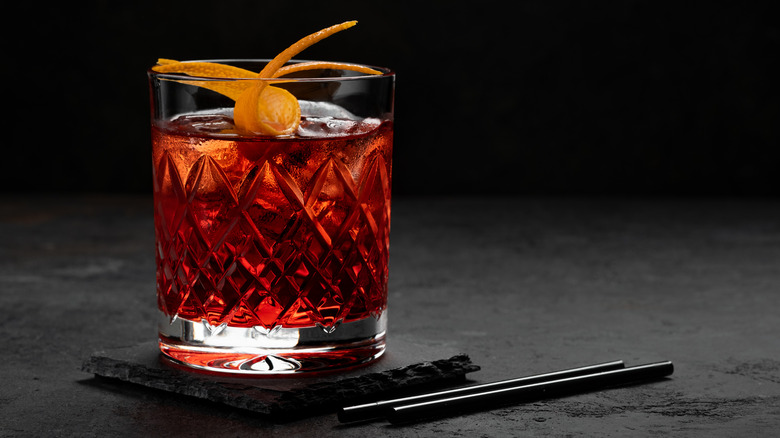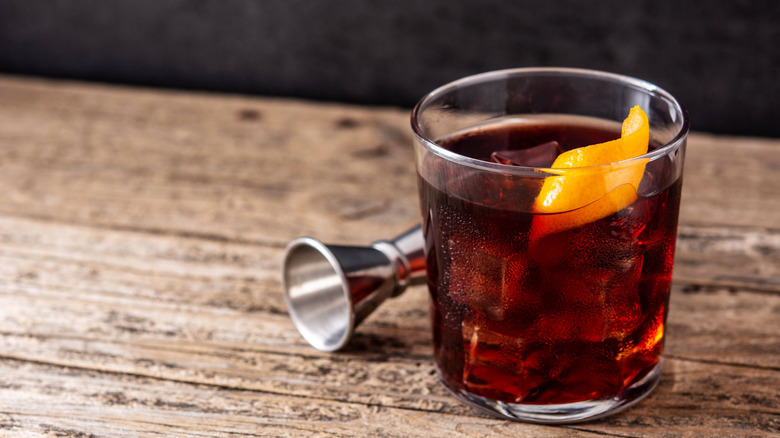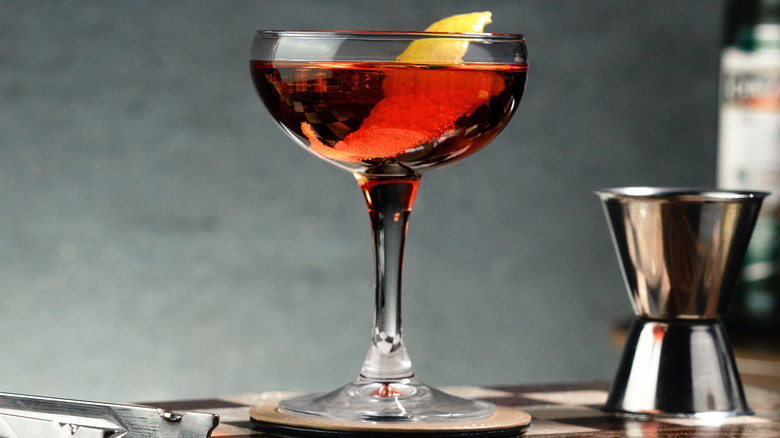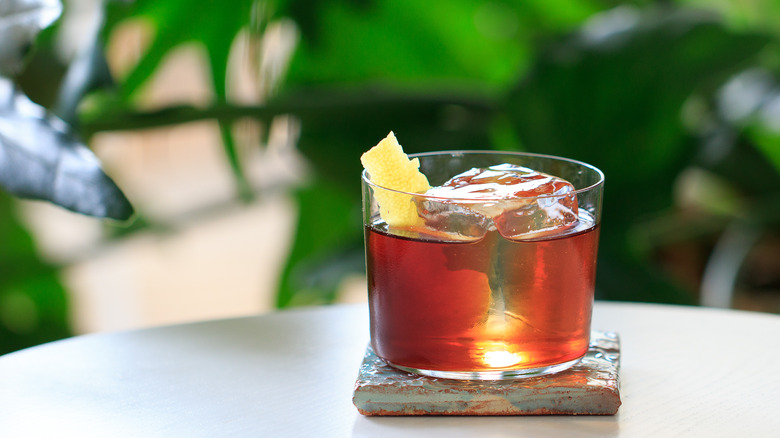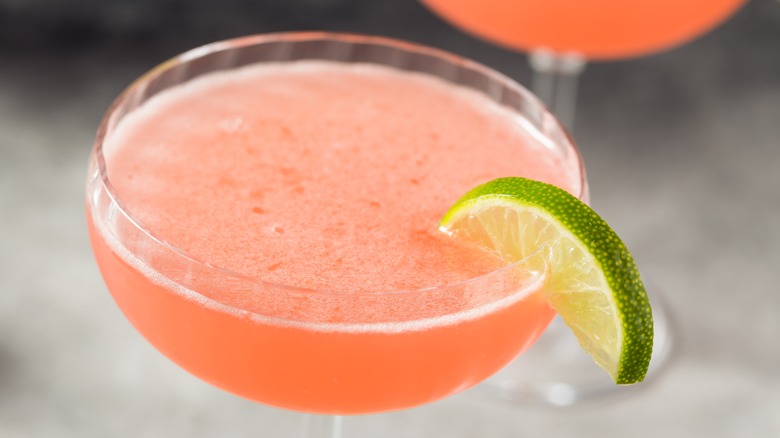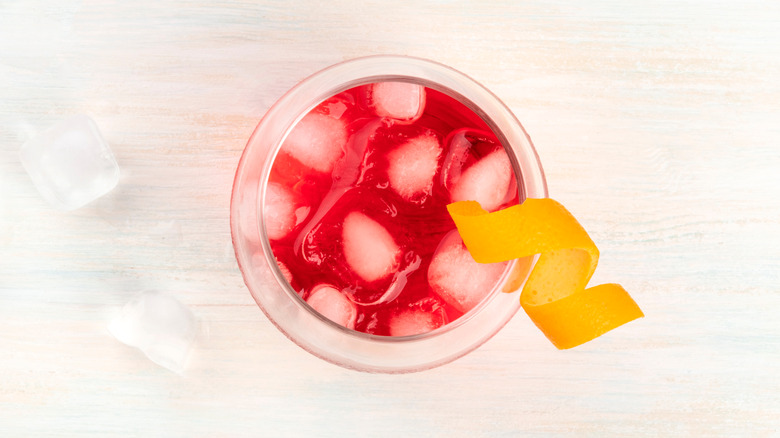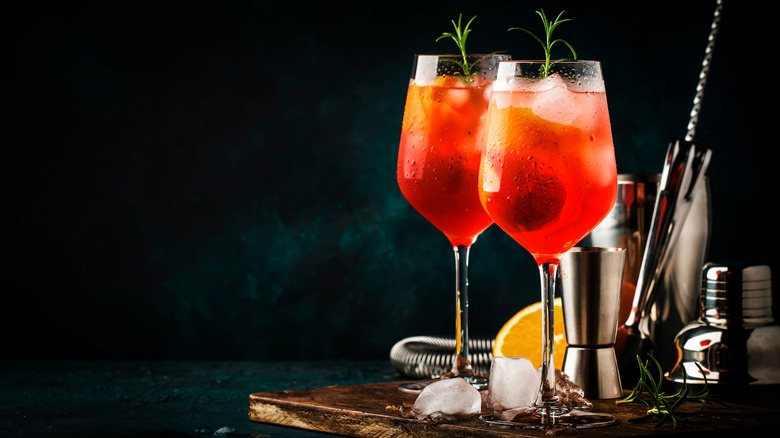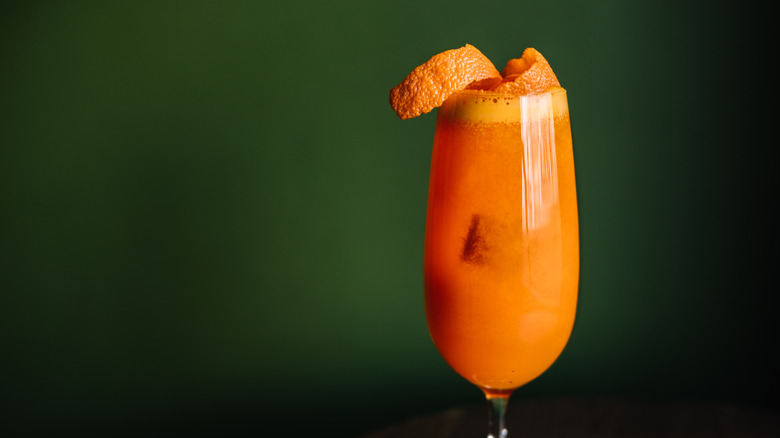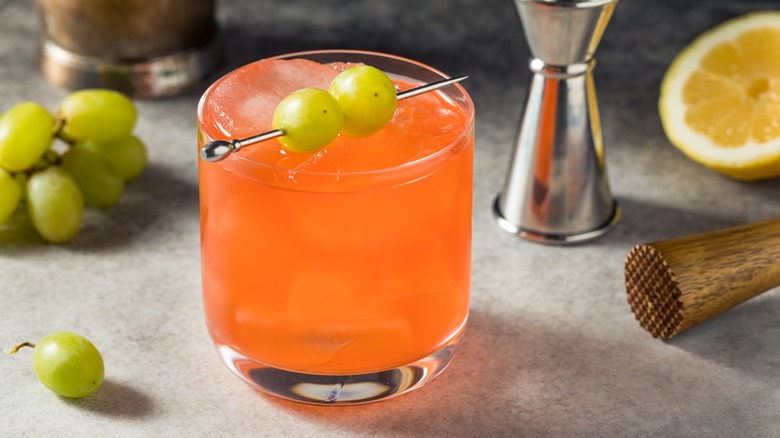The Absolute Best Campari Cocktails
Campari is a home bar staple. The Italian aperitivo contributes to some of the most iconic cocktails there are as well as lesser-known modern classics slowly making their way onto bar menus.
The invention of Campari dates all the way back to 1860, when Italian drink maker, Gaspare Campari, concocted the beverage for his company based in Novara, a town just west of Milan. The recipe for Campari has remained unaltered since the exact ingredients and measurements are only known to the few in charge of its production. The only shared information is that Campari is made from an infusion of alcohol using bitter herbs, aromatic plants, and fruit. Some guess the number of ingredients to be a few dozen and others estimate it to be over 80. The only certainty is that Campari is a one-of-a-kind liqueur and it is still popular over a century later for good reason.
Despite its assertive stamp on mixology culture, Campari remains polarizing because it is distinctly bitter. However, Campari is not supposed to be sipped on its own. The most popular and useful vehicles for Campari are simple cocktails that help combat its harshness, help emphasize its flavor, and balance it out with sweeter accompaniments.
The truth is, people either love Campari, or they detest it. The only gray area is the period of time when those trying it can't decide which end they live on. Before you cast your own judgment, it's only fair you give Campari a chance by trying some of these cocktails — ones we feel are the best Campari cocktails out there.
Americano
From the bartender! Not the barista. We can thank the Italians for both, however. This simple cocktail, which is equal parts Campari and sweet vermouth, comes from the same creator of the former. According to Nonna Box, the Americano was invented at Gaspare Campari's bar Caffe Campari soon after the liquor's creation in 1860. Initially, however, the cocktail was known as the Milano-Torino because of the combination of its ingredients: Campari, from Milan, and Punt e Mes, a sweet vermouth made in Torino.
Traditionally, the Americano is known to simply be equal parts Campari and sweet vermouth on the rocks in an old fashioned glass. The name Americano came to be in the 1920s, when American tourists visiting northern Italy were enthralled by the Campari cocktail. However, the Americans constantly requested it be modified with a splash of soda water because of the original recipe's density and stiffness, and the name stuck.
The enhanced version then began being served in a highball glass instead of the old fashioned glass it originally filled. The addition of soda helps lighten the cocktail and dilute the alcohol, making the drink more palatable and suitable for the caffé environment it was conceived in.
Negroni
The Negroni is undoubtedly the godfather of Campari cocktails. However the birth of the Negroni not only came after the Americano, it was created through the Americano. According to Spirit of York Distillery Co., the origin of the Negroni belongs to the city of Florence. It is said that in 1919, Count Camillo Negroni requested his friend, Forsco Scarselli, a bartender at Caffe Carsoni, strengthen his Americano. Scarselli obliged and replaced the soda water with gin, the lemon slice with an orange slice, and the Negroni was born.
Camillo Negroni loved the creation so much he returned home to his residence in London and became the catalyst for its popularization throughout Europe and the U.S. As fascination with the exquisitely boozy and balanced cocktail expanded, Negroni opened his own distillery in Treviso, Italy. There, his company bottled a rendered version of the cocktail and called it Antico Negroni, an operation still in production to this day.
The Negroni has transcended generations since its invention and will continue to pass through generations to come. Once a year, Imbibe Magazine and Campari partner up for their annual Negroni Week as a celebration of the cocktail's long-lasting prosperity and the many variations it has inspired, three of which are up next on this list.
Boulevardier
This cocktail is one of the few good things to come out of Prohibition. With the passing of the 18th Amendment, many bartenders migrated to Europe, including New Yorker Harry MacElhone, according to Imbibe Magazine. Once the head bartender at the Plaza Hotel in Manhattan, MacElhone relocated to a bar called Ciro's in London, and then to its branch in Deauville, France. Soon thereafter, MacElhone opened up his own spot in Paris and named it Harry's New York Bar.
Along with his fellow American expatriates, MacElhone served pre-Prohibition American cocktails, newly discovered European ones, and a combination of the two, one of which was the Boulevardier. The cocktail first appeared in publication in MacElhone's bar guide, "Barflies and Cocktails," in 1927. The Boulevardier was the favorite drink of writer and socialite Erskine Gwynn, the editor of a Parisian magazine, The Boulevardier, which is where the cocktail gets its name.
The Boulevardier is the same as a Negroni but uses bourbon instead of gin. The combination of whiskey with the sharp and herbal Campari and sweet vermouth makes this dark liquor cocktail drinkable year-round. The cocktail is served the same way as a Negroni, in a rocks glass with a slice of orange, but is a more accessible avenue to Campari. Flavor notes of bourbon are more robust than that of gin, which makes the Boulevardier more palatable, equally balanced, and always delicious.
Old Pal
According to Serious Eats, the Old Pal first appeared in one of Harry MacElhone's many mixology guides published in the 1920s while he was working in Paris, but the exact origin of this Campari cocktail remains uncertain. The cocktail also shows up in a book by MacElhone's friend, Arthur Moses, titled "Cocktails Round Town," in which Moses claims the drink got its name from a friend of his who described a drink he used to make for himself, all while referring to Moses as his "Old Pal." Others believe the cocktail to simply be a variation by MacElhone of his original Boulevardier. Nevertheless, the Old Pal is an iconic drink that, despite being very similar to the Boulevardier, stands alone as its own delicious, nuanced cocktail.
The modifications made to the Boulevardier were a swap of bourbon whiskey for Canadian rye, the sweet vermouth for dry vermouth, and the orange slice garnish for that of a lemon. The dry vermouth helps lengthen the cocktail and tone down the more dominant notes of Campari and whiskey. The substitution of bourbon for rye gives this cocktail delicate, peppery flavor notes which, when finished with a twist of lemon, make for a drier, lighter cocktail. The Old Pal may not be the most approachable starting point for Campari, but once the taste for it is acquired, this complex cocktail is sure to check off every one of your taste buds.
Mezcal Negroni
The Mezcal Negroni is pretty self explanatory. Replace the gin with the Mexican spirit, Mezcal, and you have a Mezcal Negroni. Although this cocktail does not have a storied history like its predecessors on this list, the Mezcal Negroni has become a modern classic of the 21st century. According to Punch Drink, its origin is not exactly certain, but the cocktail has stamped itself as a menu mainstay.
In the mid-2000s, mixology and cocktail bars were undergoing a revival. As the Negroni came back into the limelight, the agave-based, smoky flavored spirit Mezcal rose alongside it. The combination of the two naturally occurred and the complementary flavors help spin the original Negroni into something completely different and fresh. The new Campari cocktail has asserted itself so well that it, itself, has inspired its own variations, such as the Negroni Absinthe, made with creme de cacao, and the Negroni de Nubes, with strawberry liqueur.
The Mezcal Negroni utilizes two mixology powerhouses that came to know each other as a result of the time they coexisted in. The classic cocktail and the rapidly popularizing spirit combine to create something greater than the sum of its parts that transcends a multitude of eras and trends. The Mezcal Negroni is not a trend, however, as it is established as a modern classic and it will remain on menus and mixed at home bars for the indefinite future.
Siesta
The Siesta is another harmonious hybrid between Mexico and Italy. Basically, the Siesta is a classic Paloma cocktail with the addition of Campari. However, the Siesta was first mixed with the understanding that it was actually a modified version of the Hemingway Daiquiri, a variation of the classic rum cocktail that features maraschino liqueur and grapefruit juice. According to The Liquor Cabinet, the cocktail was created by established bartender, Katie Stipe, in 2006 at the Flatiron Lounge in New York City. This era was a sort of mixology Renaissance that championed what became known as the "Mr. Potatohead" theory, dictating that experimentation with liquors and modifiers can be done freely as long as the structure of the cocktail remains balanced.
In the case of the Siesta, rum of a Hemingway Daiquiri is substituted for blanco tequila and the maraschino liqueur for Campari. The result is an entirely new, sharp, refreshing cocktail fit for bars both indoors and poolside. The Siesta is a very approachable access point to Campari. Although its presence is always assertive, the main player of this cocktail is the tequila, which makes up more than a third of the cocktail's total volume. The tart and sweet citrus from the lime and grapefruit help null the bitterness of the Campari and a half ounce of simple syrup brings everything to a perfect balance. Served in a classy coupe glass, the Siesta is a must try come summertime.
Campari and Soda
Liquor and soda is a straightforward classic. Scotch and soda, vodka and soda, rum and coke, the list goes on. Other than sipping a spirit straight, this may be the most fundamental introduction to a new liquor. Spirit, soda, and ice are the only ingredients required and a judgment of the liquor is unhindered by any citrus juice, sugars, or other liqueurs.
The highball cocktail dates all the way back to the early 1800s, when brandy was first utilized as its main player, according to VinePair. Since then, Scotch whisky has become the icon of the highball, and today the simple combination of liquor and soda fills both high and lowball glasses alike.
Keep in mind, a Campari and soda is essentially an Americano without the sweet vermouth, so the only flavor in the drink comes from the Campari. As noted earlier, the taste for Campari is an acquired one. Since it is very bitter and the only other ingredients in the cocktail are soda water and, presumably, an orange garnish, a Campari and soda is actually a great place to start with the Italian aperitivo. Sipping Campari on its own is not particularly advised, but forming an opinion on the liqueur through this drink is the most pure vehicle.
Campari Spritz
We all know and look forward to an Aperol Spritz when the weather starts warming up, but there are many other spritz cocktails out there that are equally tasty and refreshing. According to Town & Country, spritzes date back to 19th-century Italy, when deployed troops and others visiting the country found Italian wines to be too strong; they lightened them with a splash, or spritz, of soda water. It actually was not until 1919 when Aperol was first created. The evolution of the spritz cocktail eventually evolved to what we enjoy today, an equal combination of Prosecco, or sparkling wine, and Aperol with a topping off of soda.
The Campari Spritz is a twin of the Aperol Spritz. Aperol is another bitter Italian aperitivo actually sold by the same company. The main difference between a Campari Spritz and an Aperol Spritz is alcohol content. Campari is 48 proof, while Aperol is only 22, according to A Couple Cooks. The flavor profiles of each are similar in their herbal notes, but a Campari Spritz cocktail yields a more punchy, stronger kick. If you love the easy drinking of an Aperol Spritz, a Campari Spritz is a new way to enjoy the cocktail style, you just may not be able to have as many as usual.
Garibaldi
The Garibaldi is another cocktail from, you guessed it, Italy. This drink, composed of only Campari, orange juice, and soda, is a perfectly balanced sunshine cocktail, according to The Manual. The bitter Campari is tamed with the classic sweetness of the orange juice, and the evanescence of the soda brings the whole thing to life.
The origin of the Garibaldi actually comes from the unification of Italy in the 19th century. Up until 1861, Italy was broken up into many separate regions called city states. Giueseppe Garibaldi, a revolutionary, led a movement for unification that ended in these regions coming together to form one unified Kingdom of Italy. In order to commemorate this unification, a cocktail was crafted combining an ingredient from the North, Campari, and an ingredient from the South, oranges.
This celebratory cocktail is fruity, tangy, and harmoniously balanced like the unification it represents. Served in a highball glass and garnished with an orange, the Garibaldi is a Campari cocktail perfect for brunch, sitting by the pool, or any moment in time when refreshment is required.
Enzoni / Fall Enzoni
The Enzoni and its simple variation are both modern classics. The Enzoni was created at the legendary Milk and Honey bar in New York City by Vincenzo Ericco, according to the one and only Steve the Bartender. Ericco is a trainee of Dick Bradsell, the inventor of other modern icons such as the Espresso Martini and Bramble. The Enzoni is essentially a cross between a gin sour and a Negroni. However, instead of sweet vermouth, the Campari is balanced out by the muddling of grapes. The result is a one-of-a-kind cocktail and a must try for anyone who claims they do not like Campari. A couple sips later, they may be forced to change their mind.
The Fall Enzoni replaces the London dry gin with rye whiskey. This variation comes from a bartender named Brent Falco, who worked at a bar called Cole's in Los Angeles. Falco was the mentor of Leandro DiMonriva, better known on YouTube as The Educated Barfly. The rye whiskey transforms the original, warm weather Enzoni to a more spicy, comforting cool weather one. The bitterness and sweetness from the Campari and grapes is cut by tartness from the lemon, and the dark, woody, peppery notes from the rye come through it all for a soothing, tender finish.
Both versions of the Enzoni are delicious, and if you try one, it is a guarantee you will want to try the other.
